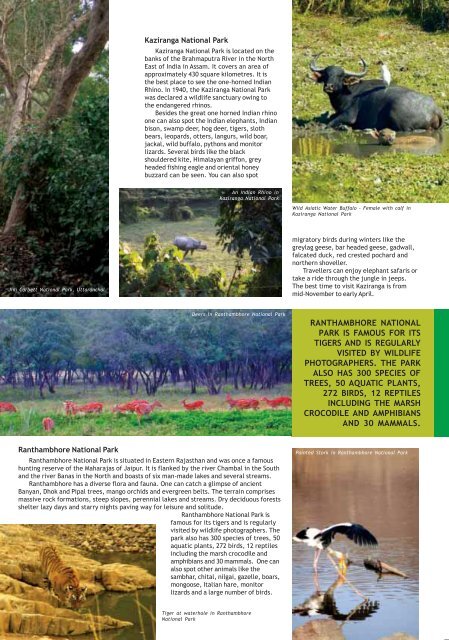SWIFT Post - LB Associates
SWIFT Post - LB Associates
SWIFT Post - LB Associates
Create successful ePaper yourself
Turn your PDF publications into a flip-book with our unique Google optimized e-Paper software.
Kaziranga National Park<br />
Kaziranga National Park is located on the<br />
banks of the Brahmaputra River in the North<br />
East of India in Assam. It covers an area of<br />
approximately 430 square kilometres. It is<br />
the best place to see the one-horned Indian<br />
Rhino. In 1940, the Kaziranga National Park<br />
was declared a wildlife sanctuary owing to<br />
the endangered rhinos.<br />
Besides the great one horned Indian rhino<br />
one can also spot the Indian elephants, Indian<br />
bison, swamp deer, hog deer, tigers, sloth<br />
bears, leopards, otters, langurs, wild boar,<br />
jackal, wild buffalo, pythons and monitor<br />
lizards. Several birds like the black<br />
shouldered kite, Himalayan griffon, grey<br />
headed fishing eagle and oriental honey<br />
buzzard can be seen. You can also spot<br />
An Indian Rhino in<br />
Kaziranga National Park<br />
Wild Asiatic Water Buffalo - Female with calf in<br />
Kaziranga National Park<br />
Jim Corbett National Park, Uttaranchal<br />
migratory birds during winters like the<br />
greylag geese, bar headed geese, gadwall,<br />
falcated duck, red crested pochard and<br />
northern shoveller.<br />
Travellers can enjoy elephant safaris or<br />
take a ride through the jungle in jeeps.<br />
The best time to visit Kaziranga is from<br />
mid-November to early April.<br />
Deers in Ranthambhore National Park<br />
RANTHAMBHORE NATIONAL<br />
PARK IS FAMOUS FOR ITS<br />
TIGERS AND IS REGULARLY<br />
VISITED BY WILDLIFE<br />
PHOTOGRAPHERS. THE PARK<br />
ALSO HAS 300 SPECIES OF<br />
TREES, 50 AQUATIC PLANTS,<br />
272 BIRDS, 12 REPTILES<br />
INCLUDING THE MARSH<br />
CROCODILE AND AMPHIBIANS<br />
AND 30 MAMMALS.<br />
Ranthambhore National Park<br />
Ranthambhore National Park is situated in Eastern Rajasthan and was once a famous<br />
hunting reserve of the Maharajas of Jaipur. It is flanked by the river Chambal in the South<br />
and the river Banas in the North and boasts of six man-made lakes and several streams.<br />
Ranthambhore has a diverse flora and fauna. One can catch a glimpse of ancient<br />
Banyan, Dhok and Pipal trees, mango orchids and evergreen belts. The terrain comprises<br />
massive rock formations, steep slopes, perennial lakes and streams. Dry deciduous forests<br />
shelter lazy days and starry nights paving way for leisure and solitude.<br />
Ranthambhore National Park is<br />
famous for its tigers and is regularly<br />
visited by wildlife photographers. The<br />
park also has 300 species of trees, 50<br />
aquatic plants, 272 birds, 12 reptiles<br />
including the marsh crocodile and<br />
amphibians and 30 mammals. One can<br />
also spot other animals like the<br />
sambhar, chital, nilgai, gazelle, boars,<br />
mongoose, Italian hare, monitor<br />
lizards and a large number of birds.<br />
Painted Stork in Ranthambhore National Park<br />
Tiger at waterhole in Ranthambhore<br />
National Park<br />
<strong>SWIFT</strong> POST • January-March 2008 • 23






